
views
Getting Better at Running
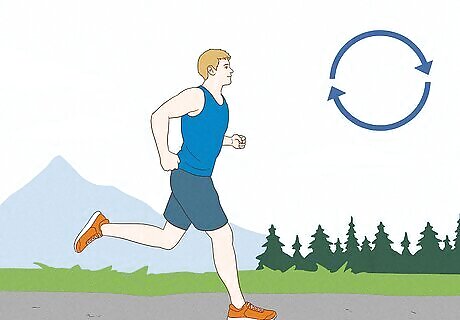
Focus on building consistency instead of speed. The key to getting better at running is to train frequently and consistently. Constant practice gives you time to perfect your form and commit it to muscle memory—this limits your chance of injury, builds your stamina, and helps you train for longer runs in the future. If you’re new to running, try going on 1-mile or 2-mile runs every other day. When you don’t feel sore the day after anymore, run 4 days per week. If you’re a more experienced runner, aim to run at least 5 days a week, with a day built-in to do some cross-training. If you run too hard in a short amount of time, it can put you at risk of injury, which means you may have to start training all over again.
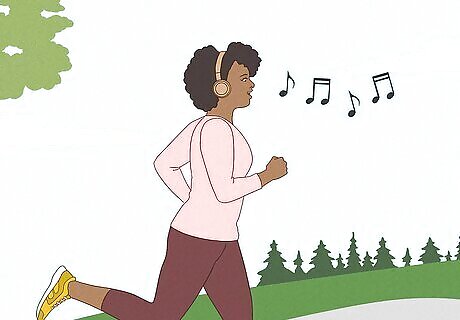
Set a comfortable pace and stick to it. Pacing yourself can be one of the biggest challenges for new runners. If you run too fast, your heart rate increases, you’ll feel out of breath, and you might not want to finish your run. Instead, run slower than you need to—this can help you warm up and figure out how much energy to put in without burning out. You can tell if you’re at a good pace if you can talk in full sentences easily. If you run by yourself, you should be able to sing along to your music without losing your breath. A comfortable running pace depends on your fitness level, age, and experience, but it’s typically a 12:00 to 8:00 minute mile (7:30 to 5:00 minute kilometer).

Add cross-training to your weekly running routine. Integrate other activities, like weight training, yoga, or swimming, into your running routine to improve muscular and cardiovascular endurance, build strength, and keep you injury-free. Introduce 1 to 2 hours of cross-training into your running volume. Use exercise bikes, ellipticals, and swimming pools to improve your strength and endurance without putting additional stress on your legs. Incorporate strength training exercises like squats, leg presses, or deadlifts to improve bone health and improve your incline running. If you’re an experienced runner who doesn’t have extra time (or energy) for a strength routine, skip one of your running days to let your body rest instead.

Run with a group or find a running buddy. A partner or group can offer companionship, conversation, and motivation to get out there and run. Find a running club in your area, join a weekly run at your local running store, or reach out to a runner on social media. If a running store near you doesn’t host any weekly or monthly runs, you can also ask them if they know of any smaller groups that meet up.
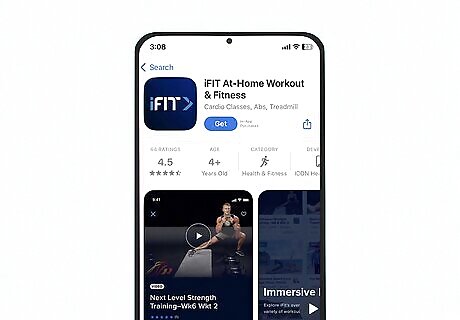
Use a running or fitness app to workout anytime, anywhere. Running apps can help you track your progress and find the perfect workout for your training regimen. The iFIT mobile app, for example, has thousands of easy-to-find workouts led by expert trainers that educate and cheer you on every step of the way. iFIT not only has running and walking programs, but also biking, yoga, rowing, and strength workouts.
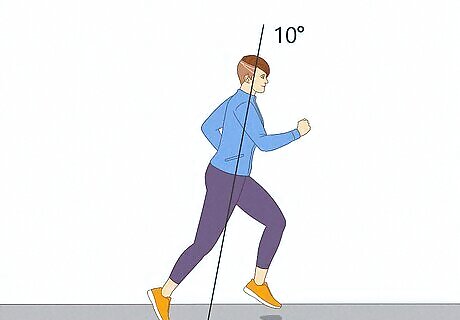
Improve your running form to prevent injury. Proper running form ensures that the ground forces run through your joints evenly, reducing the chance of injury. For example, running with your body straight up and down can put more pressure on your knees. Instead, lean forward about 10 degrees and push off with the front of your feet. Bring your head up and look forward to lengthen your spine. Relax your chest, let your shoulders curve forward, and strike the ground with your feet under your body. If you get injured or have difficulty maintaining your form, visit a physical therapist or exercise physiologist. They can perform a gait analysis and offer modifications to help you run better.

Warm up before and after you run. Before you start your workout, walk or jog slowly for 3 to 5 minutes to allow your muscles to get used to the activity. Gradually increase your speed until you can run comfortably. After you reach your goal, walk or jog for 3 to 5 minutes to cool down, prevent blood from collecting in your legs, and allow your heart rate to decrease. A warm-up widens your blood vessels (which ensures your muscles are given enough oxygen to perform), raises your body temperature for better flexibility, and reduces stress on your heart. Stretch during your cool-down to reduce muscle cramping and stiffness. Hold each stretch for 10 to 30 seconds, exhaling as you begin the stretch and inhaling as you hold it.
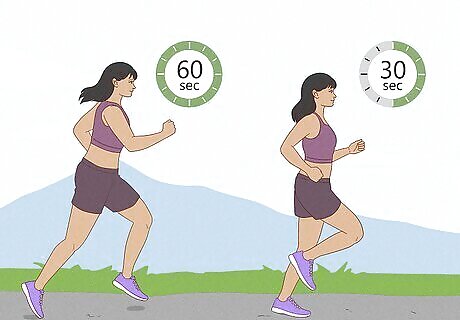
Incorporate interval training to increase your speed. If you’re looking to become a faster runner, try interval training—this involves giving maximum effort followed by a period to recover. For example, you might sprint for 60 seconds, then jog slowly for 30, and repeat this 8 times. One study on trail runners found that sprinting for 30 seconds 4 to 7 times, with 4 minutes of recovery between each sprint, 3 times a week improved their endurance and performance.

Buy running shoes that fit your feet properly. The right running shoe depends on your foot arch and your pronation (rotation of the ankle bones). To find the right shoe for you, look at the bottom of the shoes you currently use to run with. Aim to replace your running shoes every 400 to 600 mi (640 to 970 km). Stability shoes: These are best for those with normal arches and mild control problems. This might be your best option if your shoes are worn evenly across the toes and heel. Motion control shoes: These are great for flat-footed runners whose ankles overpronate. If the inside edges of the soles of your shoes are worn, try these shoes. Cushioning shoes: If the soles of your shoes are excessively worn on the outside edge, a cushioning shoe for people with high arches who tend to overpronate may be best for you. You can also visit a running shoe store and have them analyze your foot style.
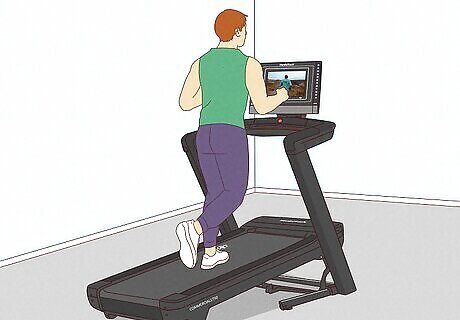
Take advantage of treadmills. Treadmills allow you to run at any time, even when it’s raining or the weather is unbearably cold or hot. They also eliminate terrain issues like uneven ground or puddles. When you’re not looking forward to your run, try transferring to a treadmill for a change of pace. Taking an indoor gym day or two might also be convenient if you don’t have time for an outdoor jog.
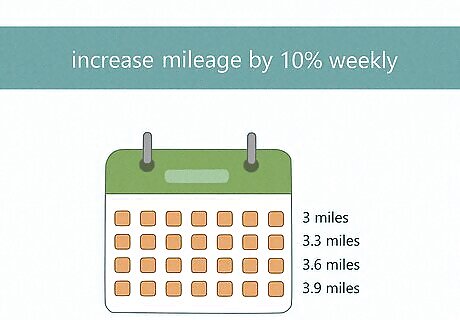
Increase your mileage by 10% each week. Whether you’re getting back to running after an injury or looking to increase your mileage, it’s important to avoid doing too much too fast. To avoid injury, increase your weekly mileage by only 10%. If you run 3 miles a week, add only 0.3 miles more the next week. If you run 15 miles a week, add 1.5 miles more. If you’re running 2 or 3 days a week, increase it to 4 to 5 times. Make sure to leave a day or two for recovery!
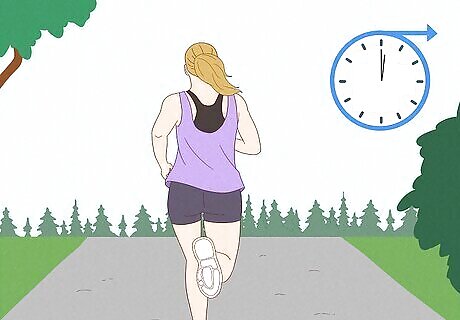
Go for longer runs on a day when you’re free. If you’re following a training schedule for a marathon or another race, try to time your longest run on a day when you’re not working or going to school. This way, you have time to prevent yourself from running too fast. To stay hydrated on long runs, take a hydration pack or handheld water bottle with you. You can also hide disposable water bottles along your route before you run. If you’re going outside, make sure to wear a hat, sunglasses (if it’s sunny), a light jacket (if it’s chilly out), and shorts or compression shorts.
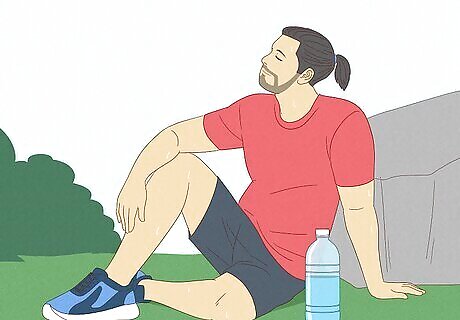
Listen to your body and make adjustments as you go. Your body gives you important feedback when running—even small changes in your breathing can be a sign to slow down or speed up. Tightness, pain, and discomfort are all signs to slow down, change your form, or stop and recover. Although aches and pains are part of exercising, if they impact or alter your ability to move normally, it’s a sign to take a rest day or see a professional. If you feel intense or immediate pain, stop, ice the area, and rest for 2 to 3 days. Talk to a doctor if the pain continues.

Eat well and hydrate before and after you run. Training doesn’t stop when you’re done running—your diet also impacts your goals. Drink plenty of water and make sure your meals include fruits and vegetables, lean protein (like fish, poultry, beans, or tofu), healthy fats (like avocado or olive oil), and carbohydrates (like rice, whole grains, or oatmeal). Most runners aim to get 60 to 70% of their calories from carbohydrates, 15 to 20% from lean protein, and 15 to 20% from healthy fats. Female runners, in particular, need vitamin D (in eggs, tuna, or fortified cereal) and calcium (in yogurt, almonds, or tofu) to promote bone health. Before running, stick with easy-to-digest carbohydrate sources like bananas, applesauce, cereal, crackers, or potatoes.
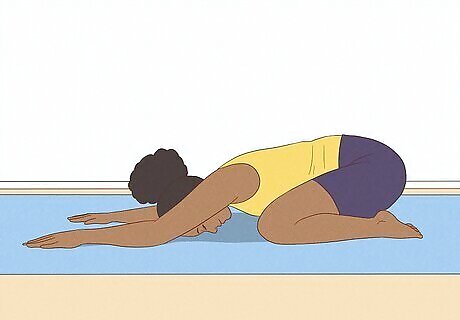
Manage your stress during off days. Running and jogging can help clear your mind and reduce stress—but if that’s the main way you relax, you might find it difficult to unwind on your recovery days. To cope with stress, try taking deep breaths, engaging in yoga (which can also count as a cross-training day), or doing other activities you enjoy. Listen to a guided meditation in a quiet location with as few distractions as possible. If you work on your recovery day, try lighting a candle, listening to relaxing music, or taking regular breaks to stand up and stretch.

Scope out the course if you’re training for a race. Whether you’re planning to complete a 5k, 10k, half marathon, or full marathon, running or walking the course can help you see what the environment will be like. That way, you can be prepared for the course before you even cross the starting line. For example, if there are hills, that’s a sign to incorporate some incline training into your running schedule. Some races have maps with aid stations so you can know when to slow down and grab a drink of water. If you’ve never done a race before, run in crowded areas or with a group to learn how to navigate obstacles and feed off the energy of the people around you.

Repeat a mantra to keep you motivated. Running is often called a mental sport—this is because your mind often gives up long before your body does. Repeating a short mantra can help chase away any doubts that you can’t go farther. When you feel like walking the rest of the way, try one of these simple sayings. “Focus, focus, focus.” “I can do it.” “Strong, confident, relaxed.” “Anything is better than nothing.” “All you have to do is finish.”

Fuel up mid-run with snacks that have fast-acting carbohydrates. Long-distance runners know the feeling of “bonking” or hitting a wall—this is when you’re body’s glycogen stores are depleted and your body starts to fatigue. To avoid the “bonk,” fuel up with 30 to 60 grams of carbohydrates 30 to 45 minutes into a run that’s longer than 2 hours. Good midrun foods include small candy bars, gel packets, sports chews, fruit drops, dried fruit, or pretzels. Some energy gels also include caffeine to give you a little energy boost during your run.
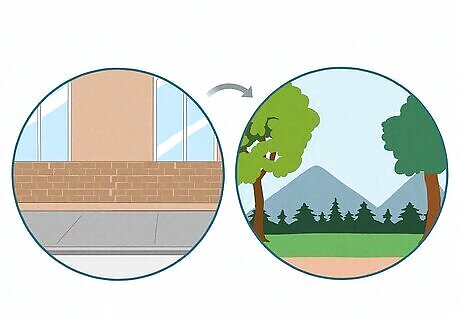
Change your route or reduce your mileage if you’re not having fun. No matter why you got into running, you probably stuck with it because you enjoy it. If you’re having trouble getting that spark back, it may be a sign to subtract a few miles each week or change up your routine. If you run on roads, try heading on a trail or try to run every street in your town. Similarly, if you primarily run on trails, try running downtown for a change of scenery. If you run at night, try running in the early morning. If you’re a morning runner, sleep in and go for a quick run after work.
Improving Your Running Speed
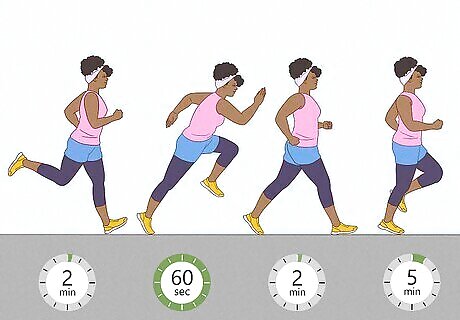
Speed-focused interval workouts Running intervals is a quick way to boost your speed and endurance. If you’re using a treadmill, the machine automatically makes adjustments for you, which means you don’t have to worry about keeping up your pace. Try this exercise: Run for 2 minutes at a comfortable pace. Increase your speed to your desired sprint pace and run for 60 seconds. Reduce your speed to a fast walk or easy jog and recover for 2 minutes. Repeat 4 to 5 times, then run for 5 minutes at a jog to cool down.
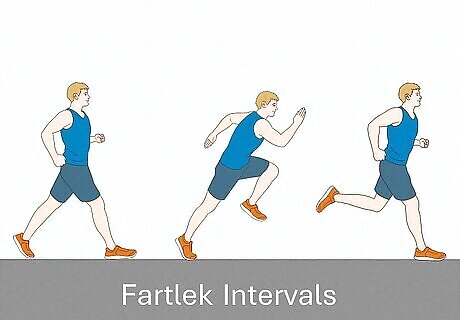
Fartlek intervals A fartlek (a Swedish word for “slow play”) is a form of interval training where you vary your speed and intensity while you run. This kind of workout not only boosts your endurance but can help you learn how to recover without stopping, which ultimately increases your speed. Try this fartlek workout: Warm up for 4 minutes with an easy jog or fast walk. Sprint for 30 seconds, then run for 30 seconds at a comfortable pace. Repeat. Run for 2 minutes at a fast pace, then 2 minutes at a comfortable pace. Repeat. Run for 30 seconds at a fast pace, then 30 seconds at a comfortable pace. Sprint for 1 minute, then run at a comfortable pace for 1 minute. Repeat this run, then cool down with a fast walk for 3 minutes.
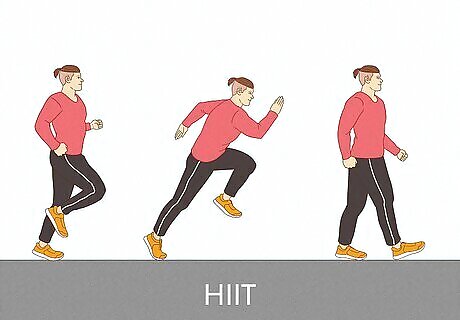
High-intensity interval training (HIIT) HIIT involves short, intense periods of exercise followed by short recovery periods, improving your cardiovascular fitness in a short time. Since HIIT only takes 20 minutes or less, it can also make an effective treadmill workout. Incorporate HIIT into your training plan: Warm up with an easy jog for 5 minutes. Sprint at a high-intensity speed for 1 minute. Walk at a slow speed for 30 seconds. Sprint at your chosen high-intensity speed (adding a slight incline if you’re on a treadmill) for 1 minute. Walk at a slow speed for about 30 seconds. Repeat 8 to 10 times until you reach 20 minutes. Cool down by walking at a slow speed for 2 to 3 minutes. Make sure to stretch afterward!
Increasing Your Running Stamina
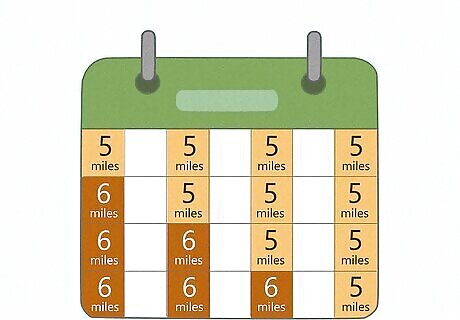
Make a consistent plan that increases your mileage each week. Training on a regular schedule each week teaches your body to adapt to your workouts, which can eventually increase your stamina. Make a plan that gently incorporates longer mileage each week and stick to it. For example, if you run 5 miles 4 times a week, you might increase 1 of the days to 6 miles the next week, then increase 2 of the days to 6 miles the week after that.
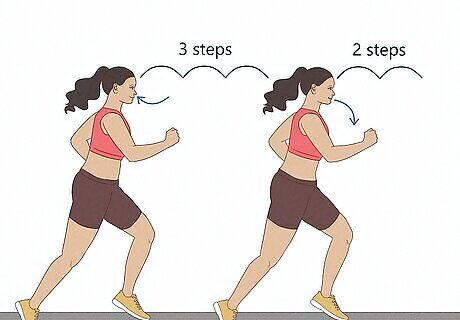
Breathe rhythmically to reduce pressure on your body as you run. Creating a rhythm between your gait (the way you run) and your breathing can help you get more oxygen and increase your ability to keep running for a long time. It can also train you to time the impact of your feet with your inhalation, putting less stress on your diaphragm, pelvis, and core. To practice rhythmic breathing, breathe from your belly. Take 3 steps as you inhale and 2 steps as you exhale so you’re not impacting the same foot as you inhale. If you’re sprinting or running at a quicker pace that requires more oxygen, take 2 steps as you inhale and 1 step as you exhale.
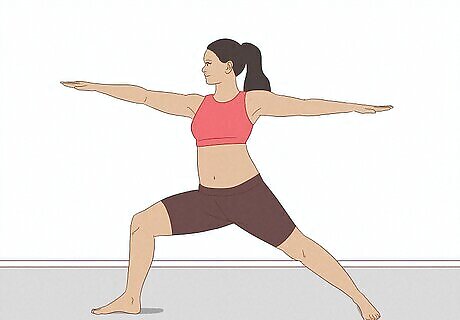
Engage in low-intensity activities on your rest days. Active recovery, which involves low-intensity activities, can help you achieve consistency without putting more strain on your body. On days when you aren’t running, try walking, light cycling, or yoga to promote blood circulation, which aids muscle repair and growth. Additionally, get at least 8 hours of sleep and drink water throughout the day to aid your recovery and enhance your performance on your running days.
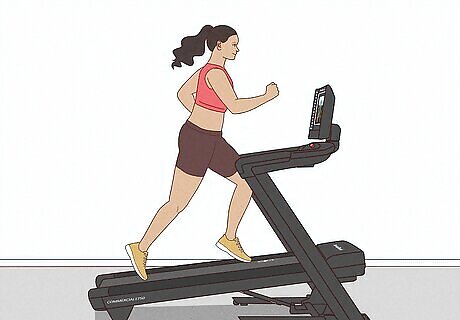
Practice hill intervals on one of your training days. Hill training can not only help you develop strength and stamina, it can help you prepare for inclines if you’re training for a specific race. If you’re on a treadmill, hill intervals tend to be less extreme than those outdoors so you can do more repetitions. Try this 50-minute one each week: Walk for 2 minutes to warm up. Run at a comfortable pace for 5 minutes. Run up a hill (or at a 4 to 5% incline if on a treadmill) for 90 seconds at a high-intensity speed. Jog on a level surface (or a 0% incline) for 3 minutes. Repeat 8 times. Run at a comfortable pace for 5 minutes to recover. Cool down by walking for about 2 minutes.
Best Treadmills for Running
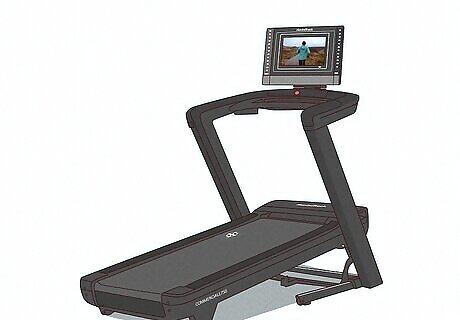
NordicTrack Commercial 1750 treadmill The 1750 is one of the most popular treadmills on the market—and for good reason. Not only does it have trainer-led iFIT workouts on a pivoting 16-inch (40-cm) touchscreen, but it also comes with RunFlex™ cushioning that absorbs impact and provides extra stability for your runs, plus an award-winning incline control feature that allows you to adjust your incline from -3% to 12%. The 1750 also comes with an AutoBreeze™ fan to keep you cool while you run, 2 premium speakers, Bluetooth connectivity, a USB-C charging port, and 2 water bottle holders. On top of that, the 1750 has a folding SpaceSaver™ design that lets you easily fold it into a smaller configuration when you’re not using it so you can save space.

NordicTrack Commercial X24 treadmill This treadmill not only has a beautiful 24 in (61 cm) HD touchscreen, but also an award-winning 40% to -6% incline feature that’s hard to beat. Like the 1750, you also get access to trainer-led iFIT workouts led by pro athletes and trainers. The X24 also comes with NordicTrack’s strongest motor, allowing you to run up to a 5-minute mile pace.
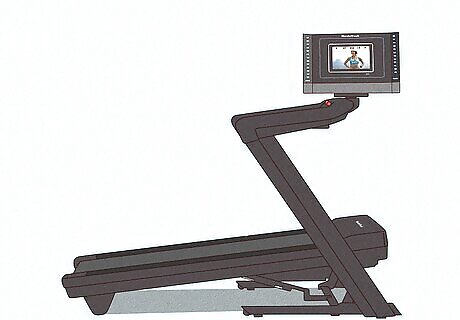
NordicTrack Commerical 1250 treadmill Whether you’re training with an iFIT trainer or running through beautiful scenery with the Google Maps feature, the Commercial 1250 treadmill has you covered. The model also has a SpaceSaver® folding design that allows you to fold up the deck and put it away when you’re finished training for the day. It also controls your incline from -3% to 12%, increasing your foot stability and toning your calves at the same time.
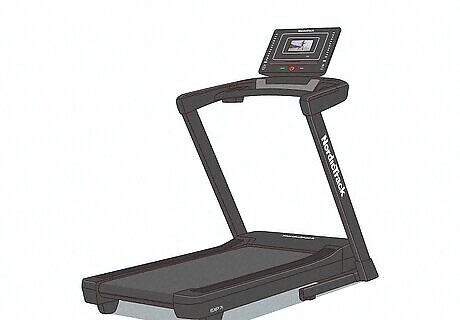
NordicTrack EXP 7i Commercial Treadmill With a 7 in (18 cm) HD touch screen display, premium speakers, and a SpaceSaver® design with an EasyLift™ Assist system, this machine was built for at home runners. Its cushioned deck also provides great shock absorption that takes pressure off your joints. This treadmill also comes with an incline feature of up to 12% and over 17,000 trainer-led iFIT workouts.
Benefits of Running on a Treadmill

It burns more calories than other cardio machines. One study found that running on a treadmill burns the most calories out of all the exercise machines tested. While you can increase your intensity on other machines to get a similar caloric output, a treadmill can also be better for aerobic low-intensity steady state (LISS) exercise, which burns calories slowly over time. LISS involves walking or jogging for 30 to 60 minutes at 60% of your maximum heart rate. LISS tends to be more enjoyable than high-intensity workouts and can be performed for a longer time. Running outside burns more calories than running on a treadmill, but the difference between the two can be eliminated by setting the treadmill incline to 1%.
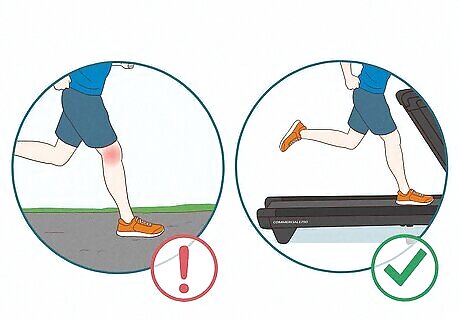
It softens the impact on your joints. Most people run outdoors on hard surfaces like cement or asphalt, which can be hard on your joints over time. A treadmill, on the other hand, is easier on your joints because it’s flat, cushioned, and free of any obstacles you may encounter if you’re running outside. Although cushy dirt trails and grass reduce the impact on your joints, you also risk tripping on uneven ground, slippery patches, or objects hidden in the ground.
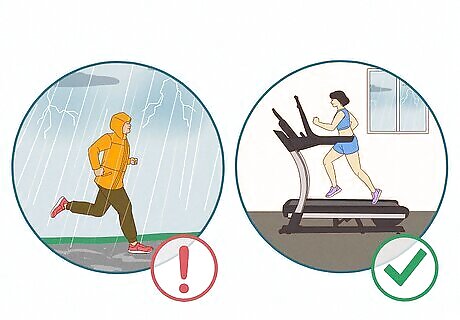
It’s safer than running outdoors. Unlike running outdoors, treadmills are free from unpredictable surfaces and bad weather conditions. You don’t have to worry about navigating oncoming traffic, bundling up for ice and snow, or getting sunburned on your morning jog. All you need to worry about is about setting a pace you can stick to. Most treadmills also come with handrails if you need support or suddenly lose your footing.

It gives you a more accurate way to track your workout. If you run outside, you might slow down for traffic or get stuck at red lights, increasing your running time. This makes it difficult to see if you’re really getting faster. A treadmill, however, tracks your progress the whole time without having to factor in external elements. It also allows you to more precisely meet your mileage goals each day.
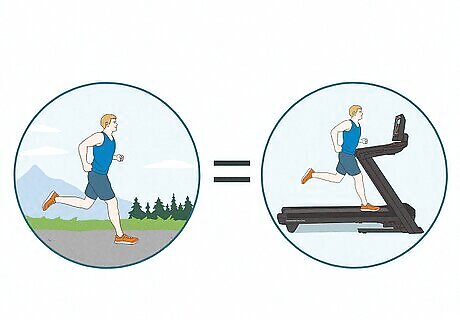
You get the same benefits as you would running outdoors. As long as the treadmill belt is properly calibrated and has the right stiffness, there’s not a huge difference between the way you run outside and the way you run on a treadmill. Running on a treadmill also results in similar oxygen consumption and heart rate when compared to running outdoors. Whether you run outdoors or on a treadmill, you’re getting a similar workout, which might be especially beneficial for those training for a race. However, the experience of running on a treadmill might be more mentally challenging without a running buddy or a good source of entertainment.
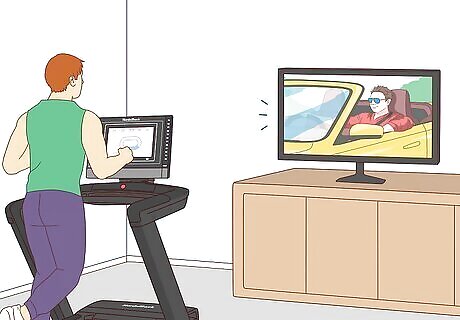
You have more options for entertainment. Running outside with earbuds blasting your favorite tunes can be unsafe, but if you’re running indoors, you can play your music as loud as you want. Running on a treadmill also means you can choose other sources of entertainment, like TV shows or movies, that wouldn’t be practical when running on the road. One study on treadmill running found that self-selected entertainment sources produced a greater physical performance than nature-based environments.
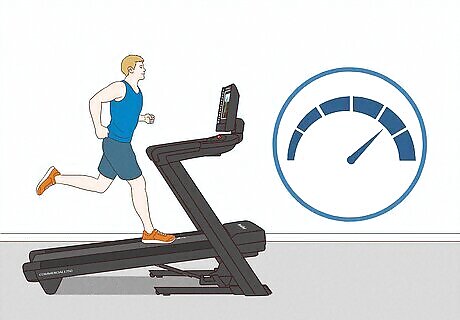
It keeps you at the same pace for longer. Treadmills keep you at the same pace, even after fatigue sets in. This can be beneficial if you’re training to increase your speed because you have to maintain a certain speed to meet your mileage within a certain time.
Tips for Running on a Treadmill

Try a virtual treadmill class. Running on a treadmill without a source of entertainment can make your workout feel monotonous and never-ending, which is why many people beat this feeling by joining a virtual group treadmill class or high-intensity interval training (HIIT) program. Some treadmills come with iFIT, an interactive fitness program that features fitness classes led by world-class trainers and athletes.

Adjust the treadmill to add variety to your pace. Running on the treadmill can be hard because, unlike running outside, your movement is more precise and you don’t make micro-adjustments to your stride. To add variety to your pace, try manually adjusting your treadmill every once in a while. You can also mimic an outdoor course by deciding the adjustments you’ll make beforehand. You might spend 10 minutes on even ground, 2 minutes at an incline, and 5 at a faster pace.

Have a treadmill running session with a virtual partner. Having someone who can hold you accountable and who you can talk to can motivate you to run more frequently and reach your goals. Hop on FaceTime with a running companion or video record yourself and send it to your partner to motivate them to do their training. Research suggests that having a running partner you like that you can compare yourself to can help motivate the frequency of your running.
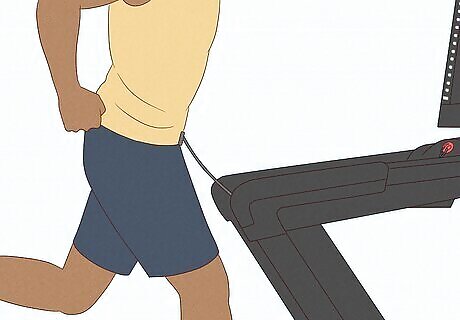
Wear the emergency stop clip. Most treadmills have a string with a little red claw clip that you can attach to your shirt or waistband. If the plug at the end of the string is pulled out of the machine, the treadmill will stop immediately. Although it may look strange, the clip can help you stay safe if you trip while running.
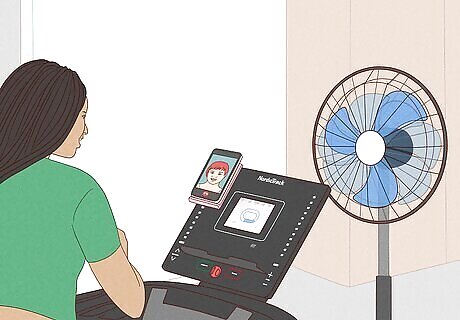
Point a fan towards the treadmill to increase the airflow. When you’re running on a treadmill, the heat from your body can create a bubble around the machine, making your workout feel more hot and humid. To increase the airflow and make you feel more comfortable when running, point a fan towards you and turn on the air conditioning if possible. You can also open the windows if there’s a breeze.



















Comments
0 comment